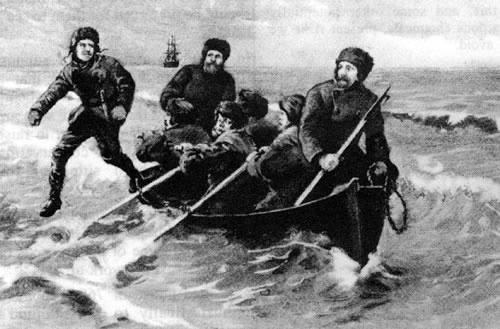
Who first stepped foot on Antarctica?
Although the honour of the first step onto the Antarctic Continent is normally credited to Englishman, John Davis, this has been disputed.
In 1893, Svend Foyn, a Norwegian shipping magnate funded Henryk Bull, a Norwegian living in Australia, to organise a voyage to find whaling grounds in the Ross Sea.
Carsten Borchgrevink, also a Norwegian settler in Australia, joined the expedition. Borchgrevink would later become famous leading the first expedition to over-winter on the Antarctic mainland (the Southern Cross Expedition).
On 24 January, 1895, Bull’s ship, the Antarctic, approached the area of Cape Adare. A boat was lowered to take advantage of the good weather and Leonard Kristensen (the captain), Alexander Von Tunzelmann (A 17 year old New Zealander), Carsten Borchgrevink, Henryk Bull, and two or three other crew members made a landing.
Henryk wrote in his journal, ‘I was sitting foremost in the boat, and jumped ashore as the boat struck, saying “I have then the honour of being the first man who has ever put foot on South Victoria Land.”’ So Henryk Bull is sometimes said to be the first confirmed person to step onto the Antarctic mainland.
However, Borchgrevink claimed in a later magazine article that ‘as soon as the order was given to stop pulling the oars, I jumped over the side of the boat… being the first man on shore, and relieving the boat of my weight, thus enabling her to approach land near enough to allow the captain to join ashore dry-shod.’ So does that make Borchgrevink the first?

To add to the confusion the New Zealander, Alexander Von Tunzelmann, maintained that he was in the bow and jumped ashore to steady the boat for Bull to disembark. Up to his death in 1957 Von Tunzelmann maintained that he had been the first ashore.
Perhaps to give Von Tunzelmann’s claim some legitimacy, in 1998, the New Zealand government officially named the place Von Tunzelmann landed as Von Tunzelmann Point.
So who was the first person to set foot on Antarctica? It probably doesn’t matter but if communication had been better back then it would have made front page news. It was the equivalent of landing on the moon, so remote was the Antarctic continent and difficult to get to.
The Southern Cross Expedition

On 17 February 1899, Norwegian Carl Borchgrevink’s British Antarctic (Southern Cross) Expedition landed at Cape Adare, one of the most inhospitable sites on earth, and set up base.
Carsten Borchgrevink was a difficult personality and managed to pretty much alienate every individual on his ‘Southern Cross’ expedition to Antarctica (1897-1900) but for all his failings as a leader he should be respected for his vision and bravery in taking the first private British expedition to the continent.
The Southern Cross Expedition was the first expedition to overwinter on the Antarctic mainland (see Adrien de Gerlache for the first expedition to overwinter in the sea ice), the first to use dogs and sledges, and they also made a series of geographical discoveries, mapped the Cape Adare region, made sledging journeys over the sea ice, and completed a ski journey to a point further south than anyone had previously reached. More importantly they proved that people could survive the long Antarctic winter living on the continent itself. The ten men spent the last winter of the century living in a tiny, cramped hut perched on the edge of a narrow wind-swept spit, surrounded by towering cliffs at remote Cape Adare at the northern reaches of the Ross Sea.. Borchgrevink’s Hut, which they built for shelter at Cape Evans, is the only example of the first building on any continent still standing and later expeditions based their activities on what Borchgrevink had discovered.
